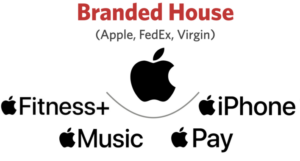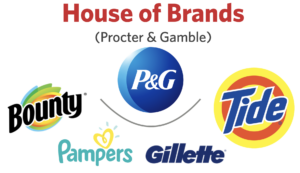The goal of any brand strategy is to build a compelling, differentiated brand.
A strong brand makes it easier for prospective buyers to pick a firm out of the crowd, recognize its value and ultimately select it. In fact, many buyers will be willing to pay a premium for the services of a provider they perceive as a category leader or as having specialized expertise. Equipped with a powerful brand, a firm can attract more high-quality leads and close a greater percentage of new business opportunities.
We can measure a brand’s strength by multiplying two brand attributes:
Brand Strength = Reputation x Visibility.
A firm with a strong reputation and high market visibility is a formidable force. This means most prospective buyers are already aware of the firm and they understand that it has much to offer.
As firms grow and mature, however, managing their brand strategy can become tricky. As the scope of its expertise expands, there is a tendency to diversify a firm’s service offering. This has the effect of diluting its differentiation and potentially confusing prospective clients.
As firms add new services and expertise, they are often tempted to brand each service separately. But that’s not always the best approach.
For a growth-oriented professional services firm, taking a branded house rather than a house of brands approach is often a smarter brand strategy.
Types of brand strategy
Let’s look at the two basic approaches to brand architecture, as well as some key benefits and drawbacks of each.
1. Branded house
In the branded house model, the firm is the brand. Services, market sectors, or practice areas are subsets of that primary brand and are not formally branded. Apple is a well-known example of this model. Under Apple’s primary brand comes many sub brands: Apple Pay, Apple Music, Apple Fitness, and iPhone (among quite a few others, such as the Mac and iPad).

Even smaller firms can manage this model. In all instances, the sub brands are recognized, but not to the extent that they overshadow or detract from the primary brand. They are all easily understood as part of a unified brand ecosystem.
In professional services, the branded house approach is also known as a one-firm brand strategy. The firm has a single brand: logo, marketplace positioning, and messaging. The subordinate services share these brand elements but deliver their own messaging points.
There are two main disadvantages of a branded house approach. First, the individual service lines are subservient to the overall brand, so it can be challenging to bring them to the attention of the marketplace. Second, if one service line is sued or takes a PR hit, the entire brand could suffer.
2. House of brands
In the second brand strategy model, focus is placed on the individual subsidiary brands, not the overall brand. The primary brand gets little or no attention. Ever hear of a company called Newell? How about Rubbermaid, Sharpie, or Coleman? Newell is a good example of the house of brands strategy—Newell is the little-known primary brand, under which come the well-known subordinate brands listed above.

The big downside of a house of brands approach is that it requires significant investment to promote and operate each brand. Think of each as a smaller independent business. Other drawbacks include competition among the brands for scarce internal resources and the challenge of building a consistent experience and culture across the portfolio.
Benefits of the branded house strategy
In professional services, the branded house strategy is the one adopted most often. Why?
In most situations, it’s far easier to build brand strength under a branded house framework. After all, it’s far simpler and more economical to channel financial and labor resources into a single brand. And, a strong brand—one with both high visibility and a strong reputation—requires diligent nurturing. Our research shows that many professional services firms overlook brand visibility, significantly weakening their brands.
In today’s marketplace, brands must be visible both online and offline.
Our research on this topic bears out the reputation–visibility imbalance. About 57% of surveyed buyers rated the sellers of professional services highly for having a strong reputation, but only about 23% thought the same sellers had very good visibility.
If your goal is to enhance both visibility and reputation it is easier to focus on a single brand—the branded house strategy.
When a house of brands makes sense
Given its inherent inefficiency, is a house of brands strategy ever a good idea? In fact, it can be.
In certain situations, state licensure requirements, funding, or liability structures can make it more prudent to pursue a house of brands approach. For example, an environmental engineering firm engaged in Superfund land reclamation services may prefer to use a house of brands structure to minimize risk to other parts of its business.
Sometimes a service line’s brand promise and audience profile drives the decision. When brands create sub brands that have very different brand promises or services—which in turn have very different buyer profiles—it can make sense to take a house of brands approach.
The key to determining what brand strategy is most appropriate for your firm depends on a variety of factors, including your strategic goals, audiences, resources, risk profile, and commitment. Using a house of brands strategy could make building your firm’s overall brand strength more challenging. And measuring the return on investment for a single brand is not nearly as complicated as assessing that same return on multiple parallel brands.
How Hinge Can Help
Hinge’s Branding Program equips your firm to stand out in a crowded marketplace and build a distinguished brand that drives sustained growth. From strategy to implementation, we take your firm through the rebranding process — painlessly and with exceptional results.
Additional Resources
- Download Hinge Marketing’s Brand Building Guide for Professional Services Firms for more insight into how to build a professional service brand.
- Watch our webinar, Digital Branding: Doing it Right, which offers advice on how to build an extraordinary online brand.
- Uncover your firm’s true differentiators with Hinge University’s course, Differentiation, Positioning & Messaging





